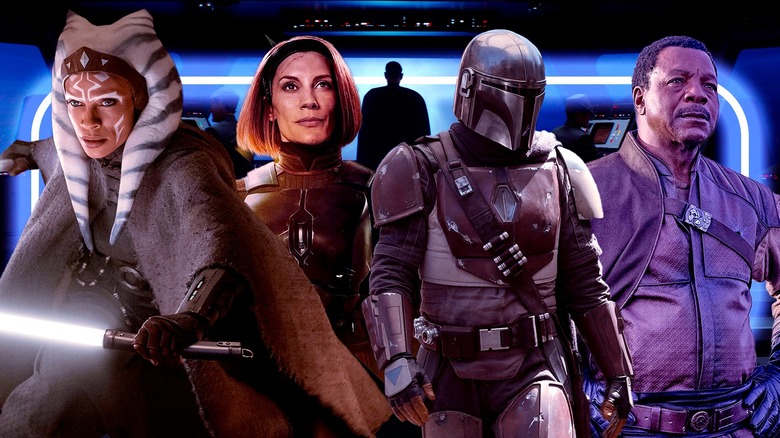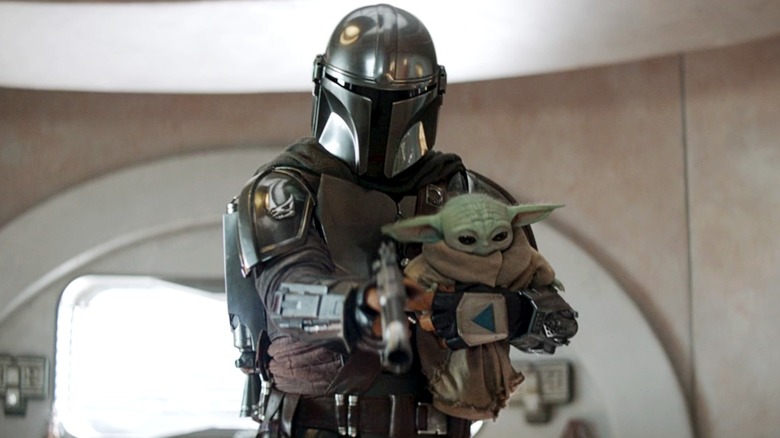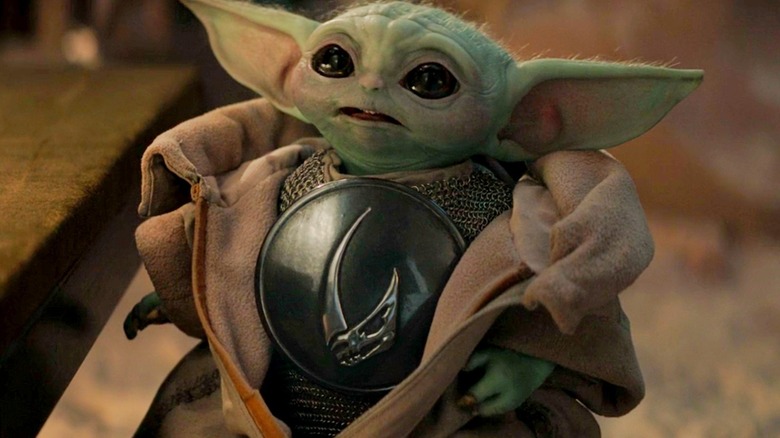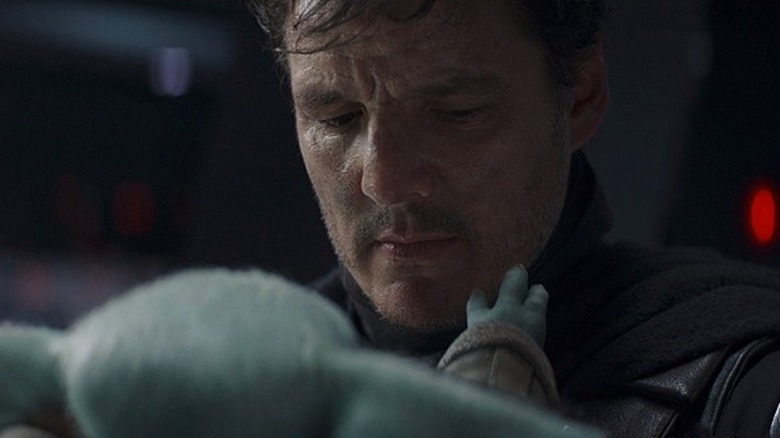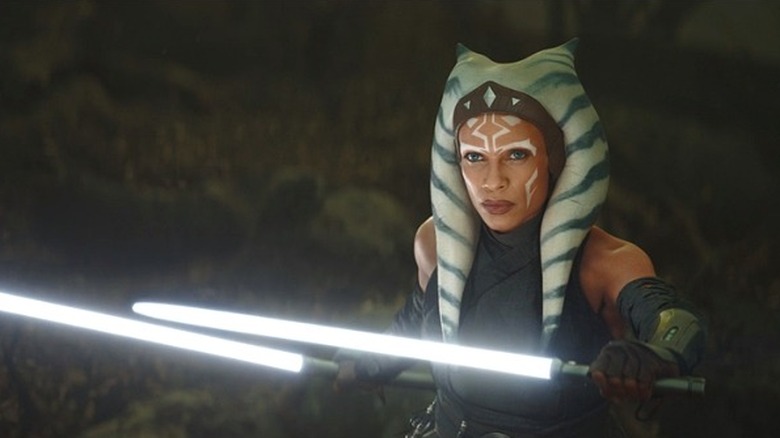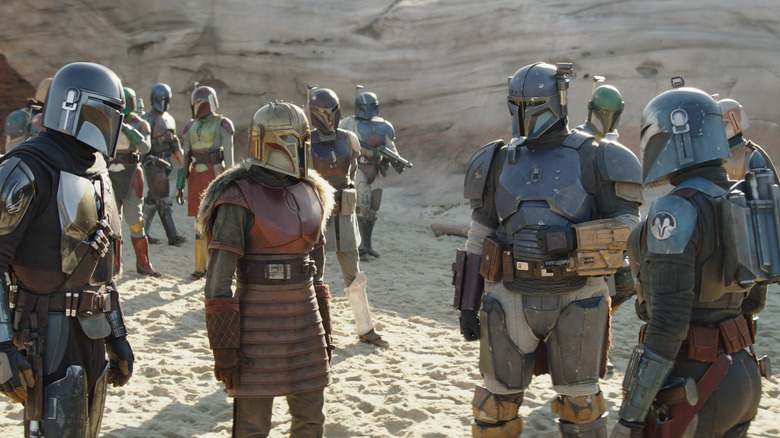The Mandalorian Has Jumped The Shark - But It's Not Too Late For A Last-Minute Rescue
It feels like an eternity since "The Mandalorian" first premiered on Disney+. In reality, it hasn't even been four years. It premiered on the same day that the platform went live, back before Peacock, or HBO Max, or Paramount+ even existed. It wasn't just "Star Wars" that looked different then, but the entire media landscape. And we were all so, so excited for the franchise's first foray into serious live-action television.
Today, "The Mandalorian" is something very different. It's not the centerpiece of original content for a burgeoning streaming platform, but just one of a dozen such "Star Wars" shows — some canceled, some panned, some yet to be released. The sequel trilogy was already divisive back when Season 1 began, but the franchise as a whole still held the allure of potential. We didn't know yet that "The Rise of Skywalker" would throw years of work into the trash, or that a show starring Ewan McGregor as Obi-Wan Kenobi would be so incredibly, detestably mid.
Halfway through its third season, "The Mandalorian" remains a high point for modern "Star Wars," but it's lost so much of what made it appealing in the first place. Its promise of a gritty, lived-in "Star Wars" story has been completely one-upped by the incomparable "Andor." More importantly, the moves the show has made to try to retain relevance have only pushed it further away from what made it great in the first place. There's no doubt that "The Mandalorian" has jumped the shark, but there is hope that it could still repair itself.
The Mandalorian was never meant to become what it is now
"The Mandalorian" Season 1 has an incredibly simple premise. It's "Lone Wolf and Cub" in space, starring what everybody wanted Boba Fett to be in the movies. It worked so well on release because it didn't demand abject loyalty to the franchise. Greef Karga, Moff Gideon, and IG-11 were the supporting characters — names with no history whatsoever in the greater "Star Wars" mythos. It was a show that seemed determined to exist in its own little pocket of space — a corner of the Outer Rim where no Skywalkers would ever wish to walk.
Sure, there was Grogu, then just Baby Yoda (remember that?), but even he didn't require any real connection to the "Star Wars" lore. People who've never seen the movies still know what a Yoda is, and questions of origin only really mattered to die-hard fans. This was the point, it seemed: to create an isolated, atmospheric, tonally distinct "Star Wars" that would be fully accessible to all kinds of fans. But by the time Season 2 rolled around, everything had changed.
The lackluster box office performance of "Solo" and the widespread backlash against "The Rise of Skywalker" prompted Disney to put all "Star Wars" movies on indefinite hiatus. Over three years later, we still don't know when the next film might come. Suddenly, streaming became the immediate future of "Star Wars" — a realm in which the franchise had only put out a single season of television. "The Mandalorian" was the one Disney "Star Wars" project that everyone seemed to actually like, so the albatross of the entire franchise was thrown around its neck.
The Mandalorian is having an identity crisis
In Season 3, "The Mandalorian" really shows the wear and tear of being the standard-bearer for Disney's "Star Wars" era. Truly, though, the show jumped the shark back in Season 2. Suddenly, the great list of new characters who populated Season 1 was replaced with Bo-Katan Kryze (Katee Sackhoff), Boba Fett (Temuera Morrison), Ahsoka Tano (Rosario Dawson), and other familiar faces. Grand Admiral Thrawn was name-dropped. Multiple spin-offs were backdoor-piloted.
Shows inevitably grow and change with time, but it's hard to see the totality of Season 2 as an organic progression from its predecessor. It was simply the only thing "Star Wars" had going at the time, and Disney shoehorned in as many cameos as humanly possible. The accessibility that made Season 1 a watercooler show — that made Baby Yoda a household name alongside Daenerys Targaryen and Walter White — began to evaporate. Suddenly, you also needed to watch "The Clone Wars," and "Rebels," and maybe read those "Aftermath" books.
You could argue that this was inevitable — that the company that built the MCU always intended to turn "Star Wars" into a tangled transmedia web. But Disney put the cart before the horse. Imagine that "The Mandalorian" Season 1 is "Iron Man," and Season 2 jumps straight to "The Avengers." But it's also still "Iron Man 2?" Scratch that, it's more like if "Iron Man" came out in 1977 and "Guardians of the Galaxy" came out in 2021. Also, if you want to know who Spider-Man is, you have to watch the animated series.
No matter how ubiquitous "Star Wars" has historically been, you can't expect every fan to have seen everything ever. In Marvel, there's a distinction between the MCU and everything else, but no such distinction exists with "Star Wars."
The Season 2 finale put The Mandalorian in a weird place
Despite being awkwardly forced into a central position for "Star Wars," Season 2 of "The Mandalorian" still has a lot of strong moments. It's fun to see Katee Sackhoff bring her animated Bo-Katan role to live action, and Din and Grogu have plenty of classic adventures. It all builds toward a climactic finale where basically every loose thread in the story is tied together. Moff Gideon is defeated, Din wins the darksaber, and Luke Skywalker himself arrives to whisk Grogu away to Jedi sleepaway camp.
What's wrong with this finale? Well, other than Luke himself looking like a weird muppet, nothing. It's a satisfying and action-packed ending to Din and Grogu's journey together that gives a hint — but not too much — of the larger "Star Wars" mythos that surrounds them.
Wait, that wasn't the end of the show? Oh, gotcha. Well, uh, let's just... give Grogu back to Din? In someone else's show, maybe?
The arc between Season 2 and Season 3 is baffling at best and a complete mess at worst. In "The Book of Boba fett," an aggressively mid spin-off that many "Mandalorian" viewers likely skipped entirely, Din is cast out from his covert for revealing his face, reunites with Grogu after he flunks out of Jedi school, and is tasked with venturing to Mandalore. Season 3 of "The Mandalorian," meanwhile, even goes so far as to break Moff Gideon out of prison, thus undoing basically everything that happens at the end of Season 2. Lucasfilm obviously always had plans for more "Mandalorian" stories, but the way the studio bridged the gap to Season 3 put the whole series in a weird place.
The Mandalorian has become too important to the rest of Star Wars
Now in Season 3, "The Mandalorian" has become the very thing it swore to destroy (or at least, be different from): a central, pivotal "Star Wars" text. The show was envisioned as a fun side story, but its popularity has made it a nexus point for the entire Disney era. It's featured numerous Jedi, other famous characters, and an entire episode set on Coruscant. It's become both a reparative project for the sequel trilogy — much in the same way that "The Clone Wars" was for the prequels — and the jumping-off point for numerous other projects. There's First Order foreshadowing, "Rebels" sequelizing, Order 66 flashbacks, and a dozen other things.
Put simply, it's bloated. Din and Grogu have practically been pushed to the edges of their own story to make room for ... the quirky eugenicist who worked for Moff Gideon? That's a trade that would never have been made in Season 1 because back then, the show had a clear purpose. Now, it has too many.
This is far from a new problem for "Star Wars." The franchise has frequently fallen into the trap of making its disparate pieces too connected. Remember when Boba Fett was just a dude, and not the most special clone boy from the Clone Wars? Remember when Tatooine was a backwater desert planet and not the place where everything important happened forever? Since the Lucas days, "Star Wars" has been obsessed with making unimportant things important. But it's the unimportant things — the Outer Rim, if you will — that made the original trilogy so compelling in the first place.
How The Mandalorian can save itself from irrelevance
"The Mandalorian" has jumped the shark — there's no doubt about that. But in true "Star Wars" fashion, there is still hope. For all of its bloated, retcon-heavy self-importance, there's still a lot of fun to be had in Season 3. Specifically, everything involving Bo-Katan, the covert, and Mandalore has been great so far.
The show is called "The Mandalorian," not "The Little Frog Jedi And Also That Other Jedi And Dr. Pershing." Shockingly, when the story focuses in on the plight of Mandalore, it shines. Sackhoff has been fantastic so far in Season 3, channeling all the complexity of her character's long history without needing to dredge up a million direct references. Watching Bo-Katan go from a hopeless loner to the hope of Mandalore is powerful, especially because she does so by rediscovering her culture through community. For so long, she was focused only on survival in the most brutal and militant way. By joining the Children of the Watch, she reconnects to the true spirit of her people.
Hopefully, the series continues to keep the spotlight on that storyline. The Mandalorians are easy to root for. They're extremely cool, have a ton of rich lore and history, and their tale of oppression and redemption is simple but effective. A show called "The Mandalorian" should be about the Mandalorians. That shouldn't be a revolutionary idea, but here we are.
